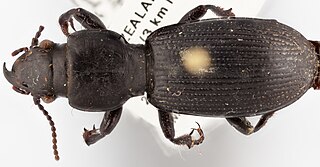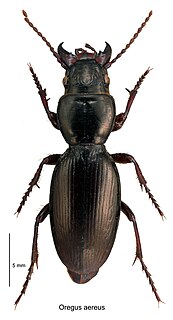
Mecodema is a genus of large flightless ground beetle (Carabidae) endemic to New Zealand. The genus is very diverse in comparison to the other three New Zealand genera within the subtribe Nothobroscina. Mecodema is geographically widespread across both the North and South Islands, as well as numerous offshore islands, including the Three Kings Is., Poor Knights Is., Aotea and Hauturu, Kapiti Is., Stephens Is., Stewart Is., Chatham Is., Snares Is.

Pterostichus is a very large genus of ground beetles with a Holarctic distribution in the subfamily Harpalinae. It has over 1,100 species. The beetles are predatory, but sometimes feed on strawberries. They can be found under rocks and prefer slightly moist, sandy soil although preferences differ between species. Pterostichus contains the following species:

Broscinae is a subfamily of ground beetles. It contains the tribe Broscini and the following genera:
Axonya is a genus of ground beetle in the subfamily Broscinae. The genus was described by Herbert Edward Andrewes in 1923 with species being found across Southern Asia and containing the following species:
Broscodes karumicus is a species of beetle in the family Carabidae, the only species in the genus Broscodes. B. karumicus is found in central and south western Asia.
Brachinus psophia is a species of ground beetle from the Brachininae subfamily that can be found in Bulgaria, Greece, Italy, Albania, Austria, Czech Republic, France, Hungary, Moldova, Slovakia, Ukraine, all states of former Yugoslavia, and in Western Europe. It can also be found on such European islands as Corsica, Sardinia and Sicily, and on the island of Cyprus in Asia. Besides European countries it can be found in Armenia, Iran, Iraq and Central Asian republics. It is also known from Turkey, The species were also found and described in Georgia in 2004, and Romania.
Adotela concolor is a species of Broscinae in the genus Adotela. A. concolor is an endemic species found in Western Australia, Australia.

Ross Taylor Bell was an American entomologist with particular interest in the invertebrate natural history of Vermont, United States, and carabid beetles. Together with his wife, Joyce Bell, his work at the University of Vermont was largely taxonomic, where they described more than 75% of the rhysodine species known to science. Ross also wrote a number of seminal papers in his chosen field.

The tribe Broscini is a worldwide group of beetles in the Broscinae subfamily of Carabidae.
Diaulota is a genus of rove beetles in the family Staphylinidae. There are about eight described species in Diaulota.
Aphilenia is a genus of leaf beetles in the subfamily Eumolpinae. It is distributed in Central and East Asia as well as southern Russia. Members of the genus are adapted to dry climates, and feed on bushes of the genus Calligonum. In 2012, the genus was moved from the tribe Bromiini to the tribe Nodinini.

Mecodema atrox is a medium-sized ground beetle species that is closely related to Mecodema curvidens. Mecodema atrox is relatively rare in comparison due to its preferred habitat, the coastal broadleaf forests of the Coromandel Peninsula, a forest type that is in decline. The body of Mecodema atrox is black and the legs are dark reddish-brown. They can be distinguished from other Mecodema species by a number of characters, including the pattern of asetose punctures along the elytral striae.

Nothobroscina Roig-Juñent 2000 is one five subtribes within the ground beetle tribe Broscini. The subtribe consists of ten genera from the Gondwanan countries: Australia, New Caledonia, New Zealand and southern South America. All of the genera are endemic to their type country, i.e., none of the genera are shared across any of the Gondwanan countries.
The subtribe Axonyina is a group of beetles in the Broscini tribe of Carabidae.

The subtribe Broscina is a group of beetles in the Broscini tribe of Carabidae.

The subtribe Barypina is a group of beetles in the Broscini tribe of Carabidae and is found throughout South America.
The subtribe Creobiina is a group of beetles in the Broscini tribe of Carabidae and is found in Australia, New Zealand and South America.
Brithysternum is a genus of ground beetle in the subfamily Broscinae. The genus was described by William John Macleay in 1873 with the genus being found in Australia and containing the following species:
Anheterus is a genus of ground beetle in the subfamily Broscinae. The genus was described by Jules Putzeys in 1868 with the genus being found in Australia and containing the following species:
Promecoderus is a genus of ground beetle in the subfamily Broscinae. The genus was described by Pierre François Marie Auguste Dejean in 1829 with the genus being found in Australia and is divided into six groups with several subgroups:







